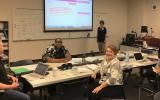Access


Leadership at Mesa Community College (MCC) and Mesa Public Schools (MPS) worked together to strategize methods to increase persistence and college attendance for high school students, with an emphasis on populations facing the most challenges. The resulting Mesa Community College High School Advisor Program creates a one-stop enrollment experience and is increasing the number of Mesa public high school students enrolling at the college.
Through the partnership, an MCC college advisor is embedded in each of the six MPS high schools to recruit students, provide seamless transition to MCC,...

Researchers define a first-generation student as the first member of a family to attend college (Chen, 2005; Ishitani, 2006; Redford & Mulvaney Hoyer, 2017). In the U.S., these students are more likely to be African American or Hispanic (Chen, 2005), come from a lower socioeconomic status (Jenkins, Miyazaki, & Janosik, 2009; Redford & Mulvaney Hoyer, 2017), and have a higher rate of attrition at the collegiate level than their counterparts (Chen, 2005; Lohfink & Paulsen, 2005; Nuñez & Cuccaro-Alamin, 1998). Students who are first-generation as well as low-income are at a...

Like most community colleges across the U.S., Kirkwood Community College embodies the widely celebrated educational ideal that it’s never too late to get a college education. This ideal is on display every day at 10 campuses spread out over the college’s seven-county service area in eastern Iowa. In fact, the age range for enrolled, degree-seeking students at the college is from 16 to 74 years old, and that range grows even wider when dual enrollment numbers are considered.
When Kirkwood first opened its doors in 1966, the educational delivery format was the same for every student, no matter...

Made possible through a new partnership between the Maricopa County Community College District and GED Testing Service, Rio Salado College students can now use their GED scores to demonstrate college readiness and college-level skills. The GED College Ready and College Ready + Credit scores are based on recommendations from the American Council on Education (ACE) Credit Program, the same program that backs CLEP and other advanced placement testing college credit recommendations. As is the case with these other programs, students may be eligible to receive college credit for courses aligned...
Tags:

Students in the Mesa Community College (MCC) Everyone Can Code iOS Apple App Development program decided that a joint project was a perfect opportunity to put their knowledge to use. The outcome? The Resource Information Services for Everyone (RISE) app.
The development team of faculty and nine students from advanced and introductory classes were assigned roles that highlighted their skills. The team researched the existing app market, developed a plan, and began developing a proof of concept. Initially, the app contained helpful markers for on-campus resources such as registration,...

Community colleges enroll over half of the undergraduate students in U.S. higher education and increasingly serve as the gateway to a postsecondary credential, particularly for first-generation and underrepresented students. As noted by researchers (Astin, 1984; McClenney & Marti, 2006; Tinto, 1993), student engagement within and outside of the classroom setting remains central to an institution’s ability to advance student success. At the same time, the growing demographic diversity of community college student bodies means there is no one-size-fits-all institutional approach to...

Breaking Down Nonacademic Barriers: Outcomes From the First Two Years of a Community School Approach
Historically, community colleges have lower completion and retention rates than their four-year counterparts. Hongwei (2015) suggested that this is in part due to the fact that leading retention models were designed for four-year institutions, not community colleges. Community college students often face unique nonacademic barriers which impact their retention and persistence rates (Goldrick-Rab, Broton, & Eisenberg, 2013; Goldrick-Rab, Broton, & Gates, 2015; Hongwei, 2015; Troester-Trate, 2017). Such barriers include, but are not limited to, a lack of resources such as food,...

Recognized as a state model in noncredit instruction, San Diego Continuing Education (SDCE) continues its reputation of leadership and innovation by implementing open educational resources (OER) that increase accessibility and textbook affordability to adult students in San Diego.
“It’s about access,” said Matthew Rivaldi, a member of SDCE’s business faculty. “The goal is to offer SDCE students free textbooks or high-quality educational materials using OER.”
OER has been a buzz-term in the California legislature since 2012, when Governor Brown signed two bills that recognized that the cost of...
Tags:

Only 25.9 percent of individuals residing in Aims Community College’s taxing district in Northern Colorado have earned a college degree or credential. In order to assist parents, families, and prospective students who are interested in college, but have no experience with the application process, Aims Community College hosts College 101 for anyone who would like to learn more about going to college. The free one-hour session is held at various locations, including the college campuses, local libraries, and community outreach centers. Dinner is provided.
At College 101, attendees learn about...
Tags:

Marlie Burt was 75 miles away from fellow classmates when she worked on a group project last semester. Burt, who lives in La Harpe, Illinois, and attends classes at Carl Sandburg College’s branch campus in Carthage, collaborated with her classmates via a telepresence robot located on the Main Campus in Galesburg, where the other students in her police administration and management course met.
Burt attended the class by controlling the robot—affectionately named Sheldon, after The Big Bang Theory character—while sitting at a computer station at the branch campus. With Sheldon, distance was no...

San Jacinto College has launched a general studies associate degree pilot program that provides significant cost savings to students who now do not have to buy traditional course materials such as high-cost textbooks.
In lieu of traditional print textbooks that can cost as much as $300 per copy, students who participate in the new program use digital open educational resources (OER) course materials which are free and accessible online. San Jacinto College full-time students previously paid approximately $700 per semester for printed textbooks, which amounts to nearly one-third of the total...
Tags:

To address the representation gap in the sciences, a partnership of institutions implemented two different early college/dual enrollment courses for high school students as part of a larger project. One program was a concurrent (in-school) enrollment program, and the other was a summer residential program. Each program ran for five years, and all of them successfully prepared students for college STEM. Many students entered STEM programs in college, and 80 percent of them are still there today.
The Larger Project
The Minority Student Pipeline Math and Science Partnership—(MSP)2—was a joint...

Nearly 30 percent of high school juniors and seniors in Colorado participated in concurrent enrollment, ASCENT (Accelerating Students through Concurrent ENrollmenT), or other dual-enrollment programs during the 2014-2015 academic year.
Arapahoe Community College (ACC) served more students (3,614) than any other two-year institution in the state during that time. ACC’s concurrent enrollment program is designed for high school students looking for a challenging academic experience while simultaneously earning high school and college credit.
“Concurrent enrollment is a great way for students to...










